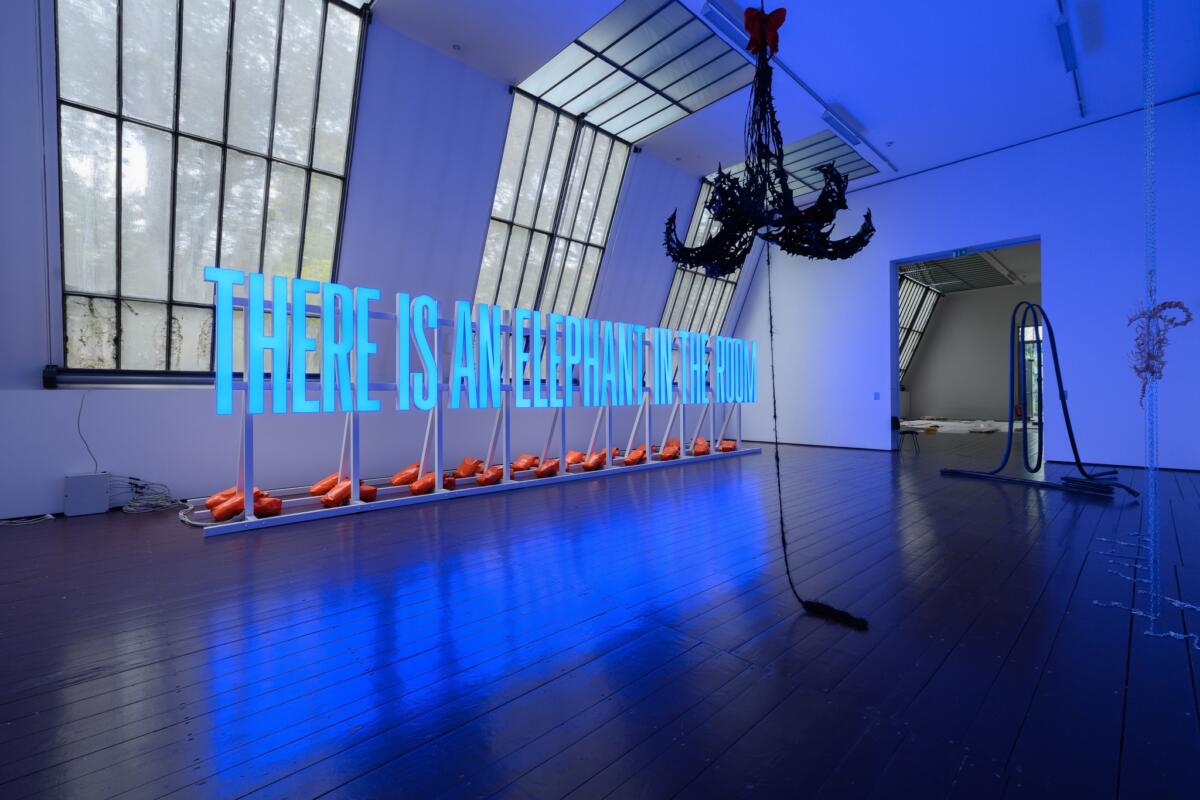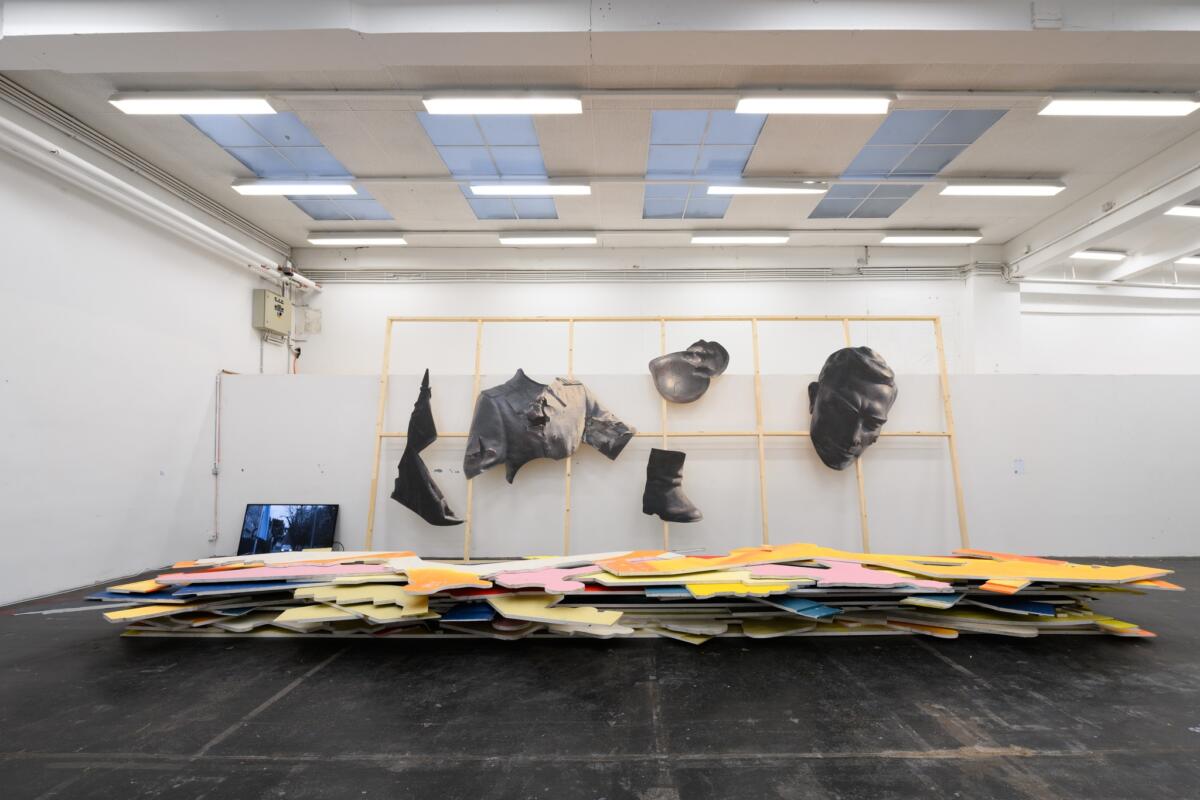
The main exhibition of the Kyiv Biennial opened on 17 October, a calm Viennese Tuesday evening, and runs through 17 December 2023. The 5th edition is the first to take place away from Kyiv, forcibly displaced by two years of the ongoing full-scale Russian invasion. While the main exhibition takes place in Vienna, a programme of exhibitions and events runs simultaneously in Kyiv, Uzhgorod, Warsaw, Berlin, and other cities, following the most common routes taken by Ukrainian cultural workers. On the night of the opening, the courtyard in front of Atelier Augarten, the main site for the Vienna edition of the biennale, was full of young artists, curators, and visitors to the exhibition, many of whom were not speaking German, but Ukrainian. The audience came from the new diasporic cultural scene that has left Ukraine for a new life in Austria, Germany, or other countries abroad. The biennial acted as a reunion point for such artists as well as the works of those who are currently engaged in military service and therefore could not be in attendance; one such work is a drawing on paper by Ukrainian artist and soldier Bohdan Bunchak, who made his drawing from the hospital after being injured while on duty. A dark undertone accompanied the small talk and the catching up: “have you heard about the hospital?” as rumours circulated about the most recent violence in Gaza. The rest of the deceptively serene city seemed entirely unaware that it was hosting an exhibition filled with timely reflections on displacement and solidarity.
The main Viennese exhibition was co-organised by the team of the Kyiv Biennial and Tranzit.at and was curated by Georg Schöllhammer, Hedwig Saxenhuber, and Serge Klymko, who chose to focus on the biennale as a connecting point between artists, Ukraine, and foreign institutions. The curators avoided totalising statements and instead chose to create a web of undercurrents about war, oppression and violence, archives of destroyed sites, and the history of Ukraine through their selection of artworks. The invited artists have either a relationship to previous editions of the biennial or personal experiences with displacement and war. Strong textual statements are in fact unnecessary as simply making the biennial is already a blunt political statement – it manages to continue regardless of ongoing war, rejecting the possibility of putting a pause on culture, and positioning it centrally and with urgency.
The giant atelier at Augarten was originally designed by Georg Lippert, an architect who started his career together with an official member of the Nazi party, constructing factories for their war industry before the end of WWII. Inside of this building, works comment on the history and spatial wounds that traverse such art spaces. Georgia Sagri’s Deep Cut (2018) is a vinyl gash that transcends the ceiling beams like open flesh, while DE NE DE Collective’s Salute (Danylo Halkin) (2022-23) displaces an entire original chandelier from a historic hotel and situates it alongside images of buildings and mapped locations on the walls that depict the “de-communisation” process in Ukraine. This controversial law sought to dismantle visual reminders of Russification and the Soviet past. These references to political architecture suffuse the entire exhibition in an air of discomfort as the legacy of fascism and architecture frame the discussion of how Russian propaganda abuses the excuse of Nazism in its war propaganda against Ukraine.

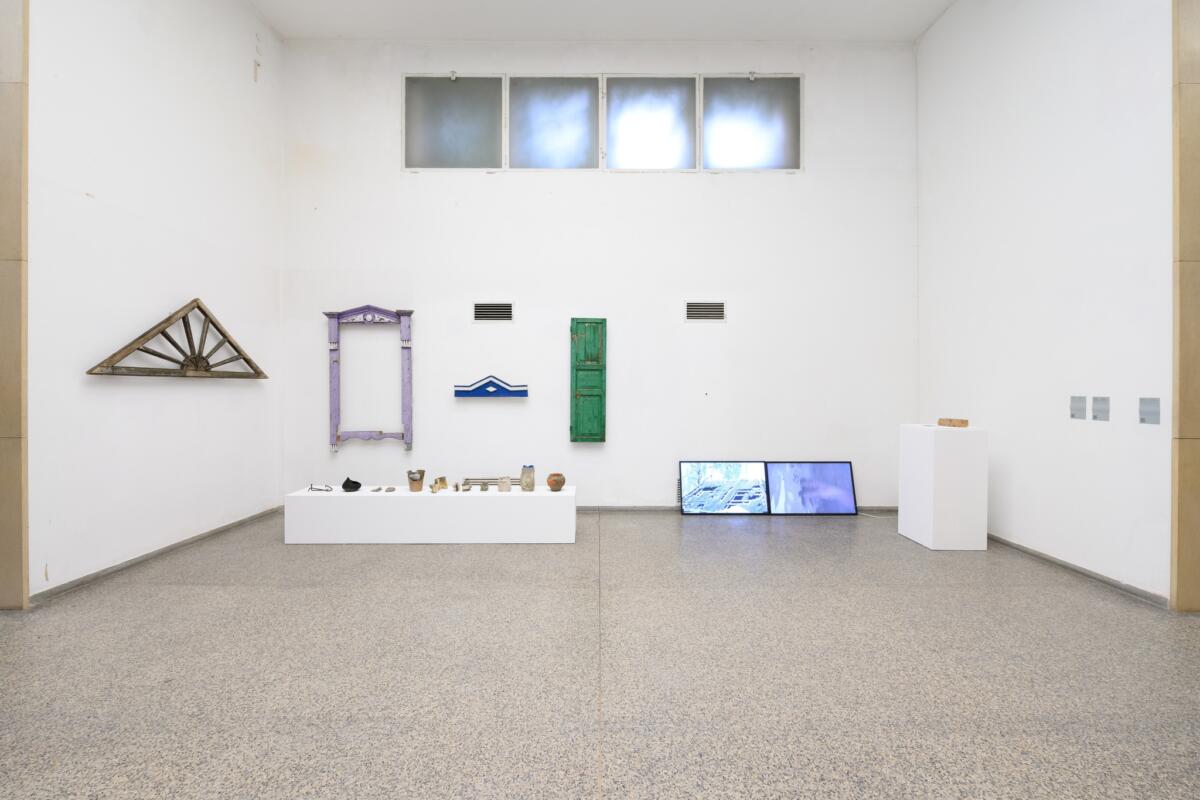
The realities of war are displayed in pieces such as Anca Benera and Arnold Estefan’s Perpetual Harvest (2023), a collaboration with artisans in the north of Romania who expertly shape straw to look like missiles. This creates a strong anti-war message and immediate visual effect built from the byproduct of grain – Ukraine’s most famous export. Important documentary work is also displayed, showing the effect of indiscriminate destruction for the people in Eastern Ukraine. The collective Livyj Bereh’s Without a jacket, bread, tablecloth, bouquet of flowers and a cross (2023) follows citizens whose houses have been bombed as they comb through remnants of their previous life. The collective currently dedicates itself to rebuilding liberated areas of Ukraine in close conversation with survivors.
The most controversial work in this pavilion is located in the centre of the building – a neon work by the Danish collective Superflex titled There is an Elephant in the Room (2023). Originally commissioned by RIBOCA (Riga International Biennial of Contemporary Art), the work found a home in the Kyiv Biennial after the Riga-based biennial was cancelled in its entirety by decision of the organisation. The piece is a striking neon sign that glows in a humming electric blue on wooden supports accentuated by bright orange plastic weights.
During the opening, curator Georg Schöllheimer exclaimed “the elephant in the room, which is Putin!” but nobody in Vienna has a problem or hesitation in discussing Putin. Therefore, we must look elsewhere to discover its meaning in the Viennese context, which was revealed by one of the collective’s members, Bjørnstjerne Christiansen, while he stood in front of the work while presenting it to the audience. He sheepishly and inaccurately explained the reason for the cancellation of the Riga biennial, measuring his words and making sure not to say anything “incorrect” under the surveilling gaze of RIBOCA commissioners Anastasia Blokhina and Inese Dabola as they stood nearby. The elephant in the room is the fact that Putin’s money is still omnipresent in Europe’s economic system despite sanctions and ethical concerns, even at the Kyiv Biennial. This work was made from the funds of RIBOCA and then displayed in Vienna. A multitude of articles have already been published establishing the connection between RIBOCA’s funding and Moscow, including in Latvian newspapers Satori,[1] Delfi,[2] and in international media such as The Art Newspaper[3], Collecteurs,[4]and BLOK Magazine.
Both RIBOCA and Superflex posted images of the work on Instagram;[5] the post still reads “commissioned by @rigabiennial & @kyivbiennial 2023.” When asked about this claim, representatives of the Kyiv Biennial responded that “There was never a collaboration or co-production between Kyiv Biennial and RIBOCA. We already asked Superflex to change their status on instagram to avoid this misunderstanding” which the artists must have ignored. From the Ukrainian perspective the inclusion of this work in the biennial is a strategic move. The large-scale work is placed in a room near the entrance, and while not visible from the first moment – it takes over prominently in the second room. Stretching from wall to wall, the work can’t avoid being a statement – produced for another context but moved to the DIY-style biennial organised from Kyiv. For RIBOCA, the transfer of this work is an opportunity to wash its image and claim that it has financially supported the Kyiv Biennial, not through transferring funds, but by finding a place to display its pre-existing production. Here, they do not fail to use the narrative that RIBOCA is somehow helping Ukrainians, as they did previously with the project “Common Ground.” In this situation however, it is really the Kyiv Biennial who is helping RIBOCA to find a place for its cancelled artwork which conveniently gets rebranded as an act of solidarity with Ukraine.

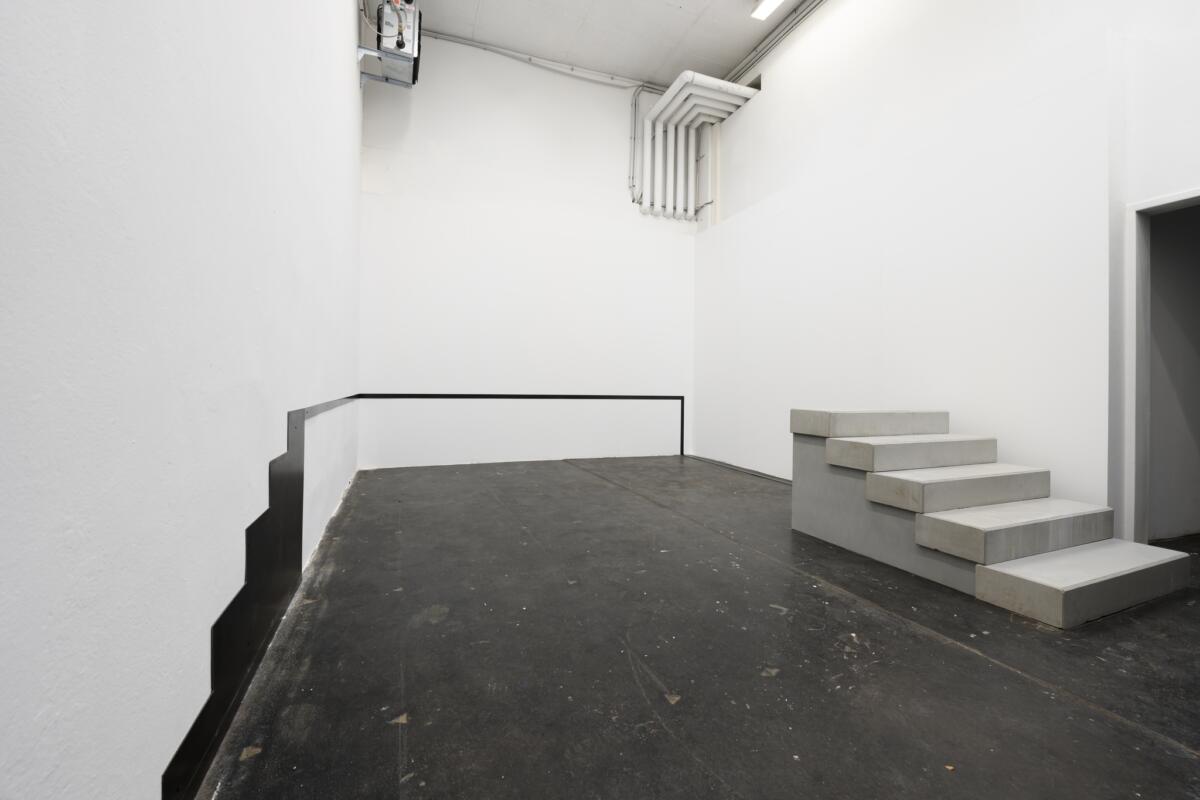
The Kyiv Biennial is spread through nine venues across Vienna, and the collaboration with local project spaces helps integrate the works into the local artistic fabric. Never at Home is a nomadic project space that temporarily occupies spaces in the city for studio use and exhibitions. In this location, projects explore the lived reality of ongoing war as it affects political thought and everyday life. Ksenia Hnylytska’s News from the Future (2022-23) is a series of digitally printed banners that display phrases of a hopeful world against landscapes or urban depictions – the artist explains that the series emerged from using the materials she had on hand including “a travel watercolour set and a mobile phone.” In a neighbouring room, Bogdan Tomashevsky’s Phantom (2023) is the ghostly outline of a destroyed school. The minimalist gesture of tracing the outlines of destroyed educational infrastructure is a form of grieving for the experiences that his son, who now lives with him in Stuttgart, will not have at his school in Germany. The transmission of culture, language, and life in Ukraine are disrupted for him, yet many of the children who stayed behind are deprived of education entirely due to the lack of infrastructure.
In the same venue we see the plans for a collaboration between Nikita Kadan and the local collective Six/Petritsch. Kadan’s On Protection of the Monuments (2023) is a nuanced reflection on the indiscriminate Russian attacks whose objectives contradict their narrative. An original monument locally called “The Hostomel Soldier” is dedicated to the memory of fallen soldiers and liberation from fascism – and while Russian mythology claims its origin in this moment of liberation, they ultimately destroyed this symbolic public work. The fragments of the Hostomel soldier were originally meant to be displayed alongside a controversial monument in Vienna, a large-scale sculpture of the antisemitic Viennese mayor Karl Lueger, who was an inspiration to Adolf Hitler and hero of Austrian fascists, which still dominates a city square bearing his name. The duo Six/Petritsch created a sculptural intervention that questioned and contested the space taken by this monument. Requests by the Kyiv biennial to install Kadan’s work in the same square were rejected by Viennese officials and the original artwork by Six/Petritsch was removed. It is displayed within the biennial halls as a dismantled pile of painted wood, as a companion fragment to Kadan’s piece. The setbacks that the municipality produced within the Kyiv Biennial are bureaucratic in nature, but highlight how administrative blockage is often used to silence the possibility for certain conversations. In the German-speaking world where censorship on contemporary issues has become shrill, antisemitic figures continue to be celebrated while new gestures criticising these monuments are dismantled.

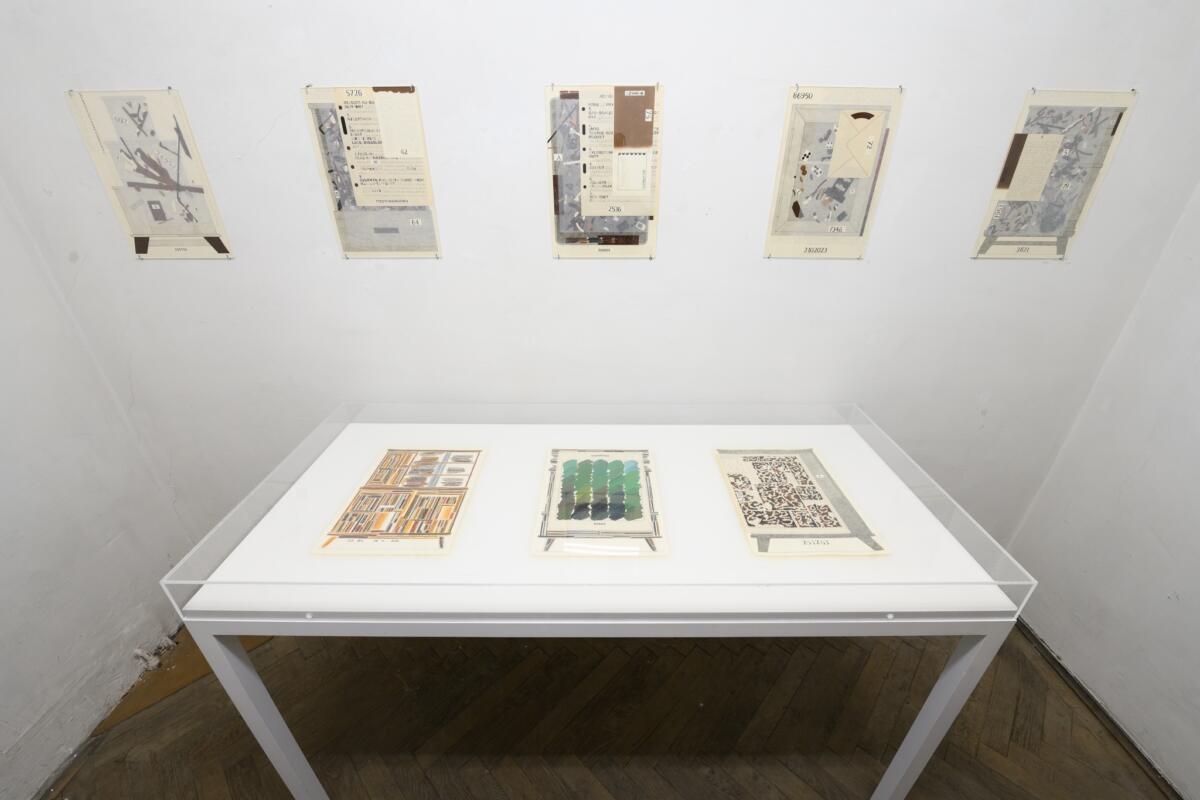
A highlight of the biennale is the centrally-located space called Laurenz which is situated inside of an old horse stable. The French artistic duo mountaincutters, who work with material violence against the body, such as viruses or toxic materials contained in sealed tubings, poetically interlace with delicate drawings by Ukrainian artist Daria Chernyshova. An assemblage of metal, glass, and liquid elements is centrally arranged in the darkened ground-floor space. Its tubes hauntingly connect architecture, body, toxicity, and archaeology in this environment. This work is placed in context with the series Intuitive Practice (2019-ongoing) by Chernyshova, which are drawings on paper on the subject of form and memory. Together these works describe lived experience as an untranslatable embodied network.
The aforementioned problems and setbacks at the Kyiv Biennial are not a negative aspect of the biennale, inversely, they enrich the exhibitions and make them even more relevant. The exhibition serves as an opportune moment to discuss the intricacies of (not only) RIBOCA’s entanglement with Moscow and what Superflex’s piece symbolises, as well as the inability to discuss sensitive topics through the works of Kadan and Six/Petritsch in an environment of clampdowns on freedom of expression in the German/Austrian sphere. Considering the ethical contradictions that displaying a work by Superflex in the context of Kyiv Biennial brings about, the exhibition is still able to utilise the work to turn it into a powerful conversation starter. The exhibition as a whole, with a fraction of the budget of typical biennials in Western Europe, is characterised by a punk and DIY aesthetic including unpainted walls and exposed cabling, and conceptualised through partnership with Vienna’s independent spaces. Most importantly, in an art world that is increasingly silent, censorious, and homogeneous, the urgency of cultural perspectives from locations of war and displacement bring about networks that celebrate tension, discussion, and discomfort, works that don’t necessarily need to agree in order to form a network of solidarity.
Edited by Katie Zazenski and Ewa Borysiewicz
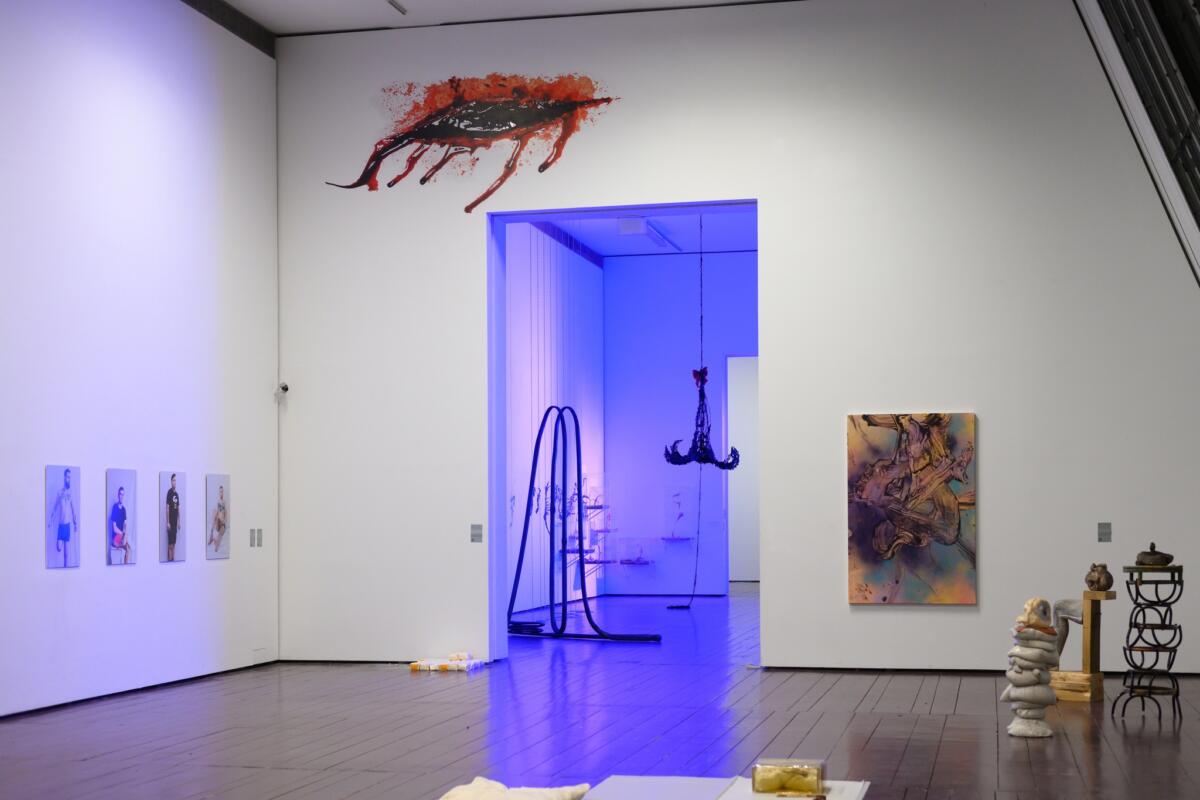

[1] https://satori.lv/article/uzsakt-biennali-ar-nepareizo-kaju-2
[2] https://www.delfi.lv/kultura/news/culturenvironment/problema-ta-pati-aizdomas-par-riboca-finansejuma-izcelsmi-krievija.d?id=55632930
[3] https://www.theartnewspaper.com/2023/07/12/riga-biennial-cancelled-after-outcry-over-organisers-russian-links
[4] https://www.collecteurs.com/interview/artists-have-withdrawn-from-riboca
[5] Screenshot of a post by Superflex Studio 23 October 2023.
Imprint
| Artist | AKT, Kateryna Aliinyk, Pawel Althamer, Vitalii Atanasov, Babi Badalov, Abdul Sharif Oluwafemi Baruwa, Luka Basov, Ivan Bazak, Mykola Bazarkin, Boji, Katya Buchatska, Bohdan Bunchak, Oleksandr Burlaka, Uliana Bychenkova, Daria Chernyshova, Davyd Chychkan, Anna Daučíková, Jeremy Deller, De Ne De Collective, Oleksandr Dovzhenko, Selma Doborac, Experimental Jetset, Mekhitar Garabedian, Gelitin, Shilpa Gupta, Danylo Halkin, Majd Abdel Hamid, Ksenia Hnylytska, Iman Issa, Nikita Kadan, Tomáš Kajánek, Šejla Kamerić, Franz Kapfer, Nikolay Karabinovych, Mikhail Kaufman, Ivan Kavaleridze, Dana Kavelina, Roksolana Kit, Alina Kleytman, Maksym Khodak, Anna Khvyl, Július Koller, Oleksa Konopelko, Arnold Kordium, Zoriana Kozak, Kreizik, Collective Kukhnia, Zofia Kulik, Sasha Kurmaz, Natalia Kushnir, Kaja Kusztra, Hamlet Lavastida, The Laundry Collective, Livyj Bereh, Aksel Lundin, Mary Lydon, Kateryna Lysovenko, Yevhen Makarov, Yarema Malashchuk and Roman Khimei, Daryna Mamaisur, Mangelos, Judy Millar, mountaincutters, Marina Naprushkina, Henrike Naumann, Yves Netzhammer, Leonid Osyka, Daniel Otero Torres, Dan Perjovschi, Patrycja Plich, Oleksii Podat, Anna Potiomkina, Olena Pronkina, Laure Prouvost, Remembering Peace, Daniil Revkovskiy, Mariia Rusinkevych, Georgia Sagri, Olesia Saiienko, Ashley Hans Scheirl, Toni Schmale, Anton Shebetko, Alexey Shmurak and Oleg Shpudeiko, Nicole Six & Paul Petritsch, Alisa Sizykh, Yuliia Solntseva, Anna Sorokovaya, Hito Steyerl, Miriam Stoney, Superflex, Waldemar Tatarczuk, Wolfgang Tillmans, Vasyl Tkachenko, Bogdan Tomashevsky, Darya Tsymbalyuk, Mona Vatamanu & Florin Tudor, Dziga Vertov, Clemens von Wedemeyer / eeefff, Myroslav Yaremak, Orest Zaborskyi, Marharyta Zhurunova and Bohdan Lokatyr, Anna Zilahi, Anna Zvyagintseva |
| Exhibition | Kyiv Biennial |
| Place / venue | Augarten Contemporary (main exhibition) |
| Dates | October 17–December 17 |
| Curated by | Georg Schöllhammer, Hedwig Saxenhuber, Serge Klymko |
| Index | Augarten Contemporary Georg Schöllhammer Hedwig Saxenhuber Serge Klymko |

